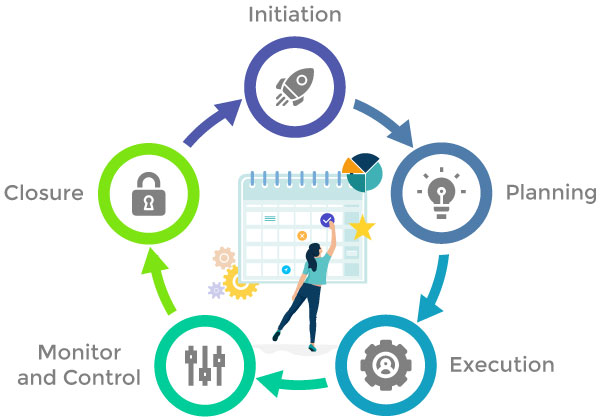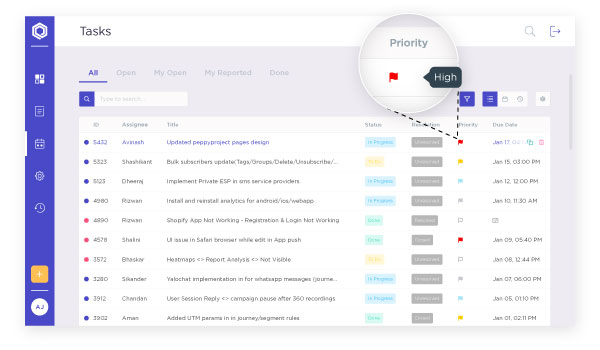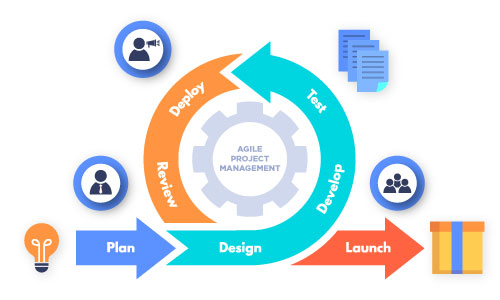5 Project Management Steps to Complete Projects Efficiently
Every inexperienced individual finds himself/herself lost and thinking about how they should go about their first projects. The instructions are straight and to the point, you can visualize taking the project from the start to the end effortlessly, follow our project management steps to manage projects efficiently.
Having a vision is good but it won’t help you learn the right approach to project management if you don’t act according to the right steps. There are some dos and don’ts you need to have in the right place before you can streamline through projects.
You may have completed some projects just by knowing your way around a project management software, that proves your mind is swift and you can adapt fast, but to really grow as a project manager, you need to master the project management process by walking up the right steps.
Even if you don’t know the first thing about the project management process, what the proper project management steps are and why you hear other project managers throw around the fancy ‘agile project management’ term, you can start learning now.
Well, dear Reader, that’s why you are here.
So, let us explore the basics of the project management process, what are the project management steps you need to follow and finally, what’s the deal with agile project management.
Let’s begin.
5 Project Management steps to complete your projects efficiently
1. Get your Project Management basics right
Managing a project is not simply managing a project when it comes to Project Management.
Project Management is a complete body of academic studies; with its books, principles, institutions, etc.
You may hear everyday words being used like tasks, tools, workflow, and for all purposes, they have complete distinct implications in the project management process.
So, what is Project Management?
In layman’s terms, it is taking a project from its very conception all the way to its successful closure. As a project manager, you will be controlling and regulating the project in its life cycle.
The project management process is broken down in 5 distinct stages throughout its life cycle. They are:

- Initiation – This is the stage where the project’s benefits and consequences are measured and whether it’s worth the undertaking.
- Planning – Once it has been decided that the project has weight and you should go ahead with it, planning starts. This is where the roadmap of the whole project is drawn.
- Execution – Starting the technical work of the project is its execution.
- Monitor and Control – This is where you as a project manager come into play. It is your job as the head to regulate the whole project management process and ensure a smooth workflow.
- Closure -After passing the previous stages and making sure everything was done right, you close the project and deliver the end result, thereby closing the project.
These are some essential basics you need to acquaint yourself with.
Moving onto the next project management step.
2. Meet the sponsors and stakeholders

Meet the sponsors and stakeholders and understand what they expect. They are the backbone of your project. Without them, there is no movement in the head, in the legs or anywhere you can think of. Your project cannot move forward without their backing.
Who is a sponsor?
The person, or several people who will provide you with the resources your project will need. They are the financial leg you will stand on during the project management process.
Who is a stakeholder?
In Project Management, a stakeholder can be anyone who is either directly or indirectly affected by your project’s outcome.
This can range from members of your team, the sponsors, the management, the target audience of the project and your organisation as a whole.
Stakeholders are not limited to the above list and they vary project to project.
In the project management process, it is crucial for you to meet them and comprehend their anticipations and how they want the project’s course to be driven.
This is not to say you should obsequiously follow their every suggestion and demand. Take their opinions into consideration and make independent decisions as much as your position gives leeway.
3. Prioritise your objectives

Understanding the complete roadmap and direction your project will take is vital to the efficient working of your team and the streamlining process of your project duration.
For this, you will need to list the primary goals your team should focus on. Effective communication is an absolute on your part. You cannot have your colleagues floating in doubts and excuses because you were the one who failed to express clearly the goals you expect them to meet.
A common acronym to keep in mind is CLEAR
Collaborative – your goals encourage the members to engage.
Limited – Your goals are concise and measurable.
Emotional – Your team is passionate about working on the project.
Appreciable – Larger tasks are divided into smaller ones for ease of attainment.
Refinable – Goals should be adaptable for shifting situations.
Let’s take a small hypothetical project.
You are a start-up. Your organisation’s main purpose is giving self-improvement workshops and coaching business personals for their careers.
Your organisation has had considerable success and now they are looking to start a branded clothing line showcasing slogans and quotes of leadership and encouragement. And the project management process falls down to you.
You decide that the primary objective, for now, is the design of the clothes so you regulate your team’s focus on that end.
One will be to research slogans; others will be the design and a third will be finding a manufacturer.
When some designs are ready, only then can you approach manufacturers for a fitting reply.
This is a very basic example and you will probably be working on more complex projects. So, prioritise your goals well and know what to do and when to do it.
What’s the next project management step?
4. Assign the team roles wisely

Randomly assigning tasks to people on your team without taking into consideration each person’s unique skill, expertise and capability will hinder your project massively.
The guy who is known for research cannot design like the person known for design. Likewise, an inexperienced fresher cannot be placed in a task management position when there are more prospective candidates on the team.
Give the writing job to the writer, the editing job to the editor, the designing job to the designer and the pitching job to the pitcher.
Having this simple ability to ascribe proper roles to each member will define your success as a project manager.
What’s the last project management step?
5. Pool the resources and dedicate yourself wholeheartedly

Take into consideration every resource at your disposal and give your heart and soul.
If a project is not done with excellence, it should not be done at all. Perfection is not necessary, but striving for perfection is.
Even if the project is not large-scale, your team members and you, their project manager, should invest yourself in the work emotionally, not just intellectually.
Everyone must be passionate about the roles they are assigned and the tasks need to be completed with determination.
What is Agile Project Management?

The Agile approach to project management is often described as being an iterative process where instead of working on one wholesome outcome, you work on several mini outcomes in sprints so your project has a satisfying result.
The Agile project management style has two very famous and commonly known frameworks. These are the Scrum framework and the Kanban framework.
Agile project management is used for those projects which are prone to rapid direction changes. It’s aimed at those projects which tend to turn around their outcomes, directions, teams, target audience, etc.
A lot of companies in the Software Development industry are frequently found to be using the Agile methodology to go about their way in handling the projects.
Agile project management is one of the iterative methods in the project management process. Its main concern is to break down large burdensome tasks into smaller sizable and actionable ones. Thus, making your work easy for you.
Which service makes everything we discussed easy for you to apply?

After going over many platforms available, PeppyBiz stands out as a resourceful service.
PeppyBiz offers a Kanban board view which makes Agile project management for your projects extremely easy for you
It offers many innovative features that help you gain the head start in your venture as a prospective project manager in the making.
Its tools and programs make it easy for you to break down your projects and regulate them with a user-friendly interface, timelines, Gantt charts, and many more.
What’s best is PeppyBiz offers a free scheduled demo for you. So, you can apply every project management step in the project management process you learned about and start practising Agile project management with the help of their project manager.
Conclusion
Remembering and understanding the project management steps we stated in the post is simple and easy to follow up. Practising them in your venture will take you a long way as a projective manager.



